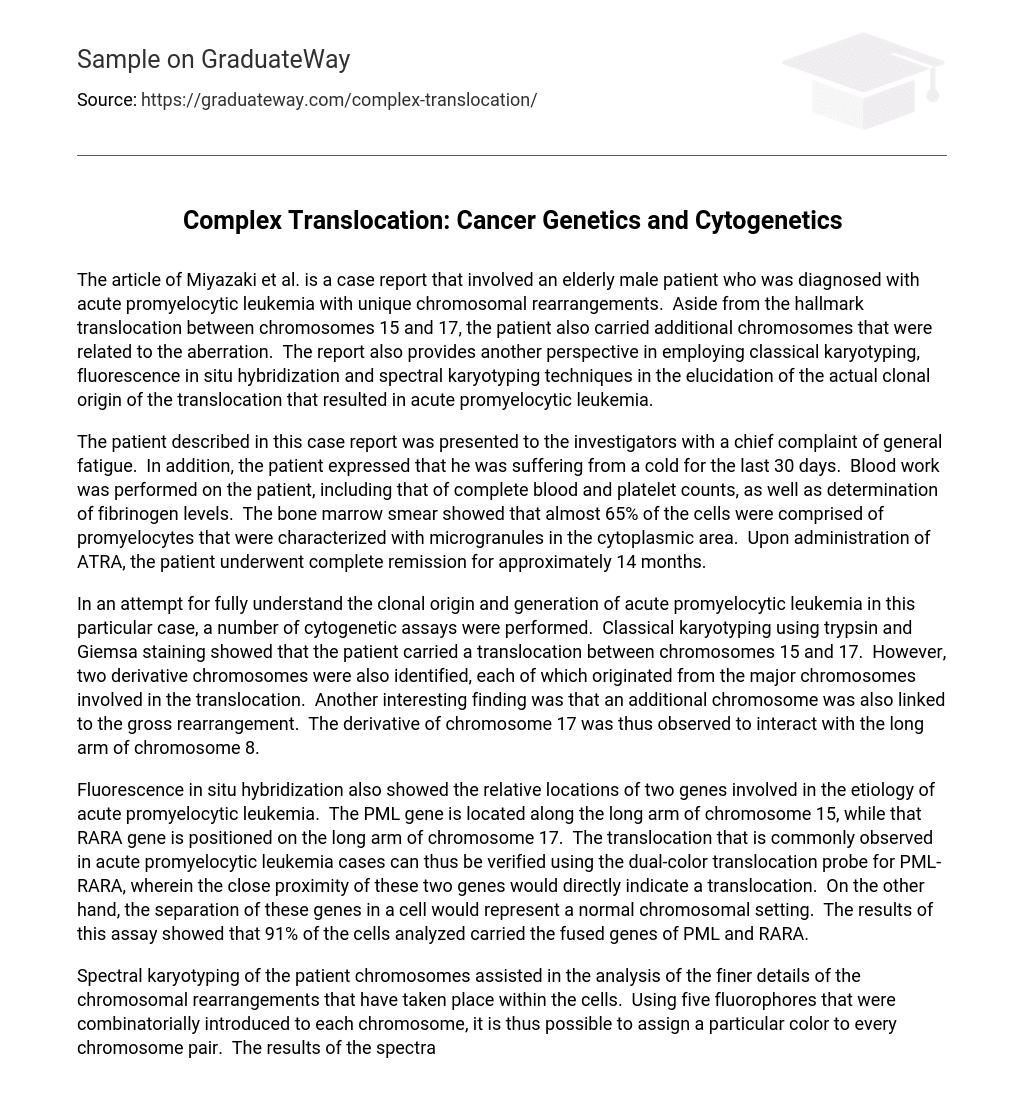The article by Miyazaki et al. is a case report that involves an elderly male patient diagnosed with acute promyelocytic leukemia and unique chromosomal rearrangements. In addition to the hallmark translocation between chromosomes 15 and 17, the patient also carried additional related chromosomes. The report provides insight into the use of classical karyotyping, fluorescence in situ hybridization, and spectral karyotyping techniques to determine the clonal origin of the translocation that led to acute promyelocytic leukemia.
The patient presented to the investigators with a chief complaint of general fatigue and expressed suffering from a cold for the last 30 days. Blood work was performed, including complete blood and platelet counts, as well as determination of fibrinogen levels. The bone marrow smear showed that almost 65% of the cells were comprised of promyelocytes characterized by microgranules in the cytoplasmic area. After administration of ATRA, the patient underwent complete remission for approximately 14 months.
In an attempt to fully understand the clonal origin and generation of acute promyelocytic leukemia in this particular case, several cytogenetic assays were performed. Classical karyotyping using trypsin and Giemsa staining revealed that the patient had a translocation between chromosomes 15 and 17. However, two derivative chromosomes were also identified, each originating from the major chromosomes involved in the translocation. An additional chromosome was also found to be linked to the gross rearrangement. The derivative of chromosome 17 was observed interacting with the long arm of chromosome 8.
Fluorescence in situ hybridization revealed the relative locations of two genes implicated in acute promyelocytic leukemia. The PML gene is located on the long arm of chromosome 15, while the RARA gene is situated on the long arm of chromosome 17. The dual-color translocation probe for PML-RARA can confirm the translocation commonly observed in acute promyelocytic leukemia cases, as it indicates a direct translocation when these two genes are closely positioned. Conversely, a normal chromosomal setting would show these genes separated within a cell. The assay results showed that 91% of analyzed cells carried fused PML and RARA genes.
Spectral karyotyping assisted in analyzing the finer details of chromosomal rearrangements within patient cells. Five fluorophores were combinatorially introduced to each chromosome, allowing for the assignment of a particular color to every chromosome pair. The spectral karyotyping assay revealed three types of clones related to acute promyelocytic leukemia development. One clonal type involved simple translocation between chromosomes 15 and 17. The second clonal type transferred chromosomal segments from chromosomes 8 and 15, reintroducing them into chromosome 17. The third clonal type transferred genetic material from chromosomes 8, 15, and 17 before reintroduction into chromosome 14. Additionally, there were also chromosome segments originating from chromosomes 8 and 15 inserted into acceptor chromosome 17.
This case study provides a unique perspective on the molecular genetic etiology of acute promyelocytic leukemia. The elucidation of the stepwise transfer of genetic material from donor chromosomes, such as chromosomes 8, 15, and 17, provides additional information on the progression of the disease. The information provided by this case study may also be employed in designing future research studies on the genetic aspects of acute promyelocytic leukemia. It is highly likely that there will be more chromosomal rearrangements documented in the future that may be similar to those described in this case study.
Reference
- Miyazaki K, Kikukawa M, Kiuchi A, Shin K, Iwamoto T, and Ohyashiki K conducted a study on complex translocations derived stepwise from standard t(15;17) in a patient with variant acute promyelocytic leukemia. The results were published in Cancer Genetics and Cytogenetics in 2007 and showed that the patient had developed unique chromosomal abnormalities.





